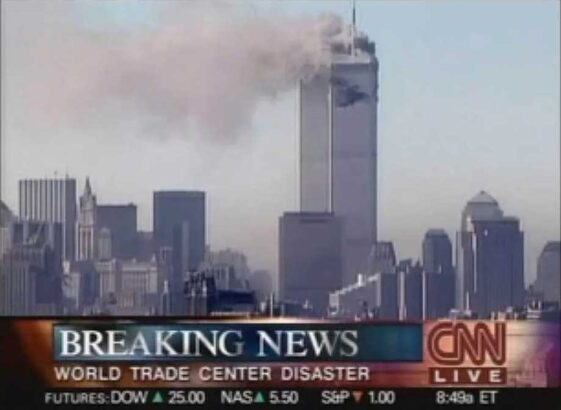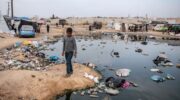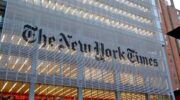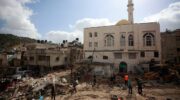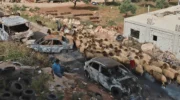There was a candlelight vigil in East Jerusalem on the night of the 9/11 attacks, Yassir Arafat gave blood, schoolchildren around the country took part in moments of silence…
Instead, the media showed the same 30-second clip over and over… The obvious agenda was to rally its viewers around the very crudest response to the news: violence needed to be met with more violence and a political clampdown…
Probably no single film clip in recent history has had as much of an impact as the Palestine clip. Summing it up was Ehud Sprinzak, an Israeli expert on terrorism, quoted in Reuters referring to the clip: “From the perspective of Jews, it is the most important public relations act ever committed in our favor.”
Three additional reports below (two from German media):
By Matt Taibbi, reposted from eXile, September 20, 2001 [photos below added by IAK]
I don’t know how long 30 seconds of videotape is. A foot? Two feet? It can’t be much. And yet that’s all it took for CNN, in one of the most outrageously irresponsible editorial decisions of our time, to sentence an entire nation to death.
We all saw the pictures. About an hour after the bombing, CNN— using videotape purchased from the two largest news video production houses, APTN and Reuters— broadcast scenes of Palestinians, mainly children, celebrating the attack on America.
The montage lasts exactly 30 seconds. There are five scenes in the sequence. They are, as follows:
1) A shot of a white station-wagon taxi pulling away from a storefront. The taxi pulls away to reveal a group of Palestinians in the Arab section of Jerusalem standing in front of the store. Though the taxi driver appears to be smiling, no one else is celebrating in the picture. The shot lasts about six and a half seconds.
2) The longest shot of the sequence. It features a group of children, two of whom take turns appearing directly in front of the camera, apparently shouting “Allah Akhbar!” and waving the Palestinian flag. The second child has a distinctly irrational, intoxicated gleam in his eye. This sequence lasts just over ten seconds.
3) The third shot, the shortest, shows a Palestinian man extending a plate with a pastry to an unseen person. There is a smile on his face. If this shot were broadcast at any time other than in the immediate aftermath of the attacks, it would be appear absolutely meaningless. But in the context, it— and in particular the vaguely satisfied smile of the cafe worker— comes across as fraught with meaning. This shot lasts about as long as it takes the man to walk some six feet to deliver the pastry— about four seconds.
4) The second-longest shot. A matronly woman in glasses and a shawl, seemingly in her fifties, is beaming and pumping her two upraised hands in celebration. All around her, children are jumping up and down and cheering. The shot lasts about seven seconds.
5) The last shot. A white van containing three men in the passenger seat is honking its horn and moving through the street. All around the van, children are cheering. One jumps on the hood of the van, then jumps off.
My very first thought, when I saw those scenes, was that the shots were fakes. I had a very strong suspicion that the footage was old. This was not paranoia. It was a logical inference, based upon the circumstances surrounding the airing of the sequence.
As it turns out, the pictures were real. Despite rumors to the contrary that have been flying around the internet, these celebrations really did occur, and they really were captured by Western news agencies.
But the reasons reporters like myself were forced to independently confirm that fact (I went so far as to call the APTN bureau in Jerusalem, and contact the press watchdog agency FAIR, which had also inquired about the footage) were the same reasons that made this sequence so shockingly irresponsible. If CNN had not so far overstepped its bounds in running this sequence in the manner that it did, there would have been no reason to suspect the footage’s authenticity. If they had even in been in the ballpark of journalistic ethics, there couldn’t have been any questions at all.
The television news business carries with it a set of ethical problems that are a world apart from the concerns of print journalists. Because they are so routinely ignored, few people— particularly people whose only relation to TV news is as a consumer— are even aware of them. They mainly involve problems of attribution and context. Very often, they’re exactly the opposite of the problems one encounters in print journalism.
Anyone who has worked as a print journalist knows he has certain advantages over the television reporter. A print journalist can walk around in the middle of a news event and not be observed. Because he’s not operating a camera or concentrating on the logistical problem of getting someone to go on the air, he usually has much more time to simply watch and digest what is happening in front of him. A print journalist can recall something from memory, whereas in television, memory is useless.
More importantly, a print journalist always knows he can construct his narrative after the fact. He does not have to be concerned with the purely mechanical problems of story construction while he is covering the story. A print journalist does not lose his story if, for instance, he does not catch a defendant walking out of a courtroom. But a TV journalist covering a trial has to catch people going in and out of various buildings, walking their dogs, stepping out of planes— all utterly meaningless events to the print journalist, but of critical importance to the TV journalist, who needs these moments to “establish” the outline of his story.
One last thing. Print journalists in some ways have much more room to lie. When a print reporter publishes a man-on-the-street interview, only God will actually know if that interview ever happened. There is no way to track down the those kinds of sources in print. But on television, you have to get a picture, and a picture is difficult to fake, particularly since it requires a conspiracy of many (the reporter, his cameraman, his producer, his editors) to make it happen.
On the other hand…
On the other hand, the very absence of a lengthy narrative instantly absolves the TV reporter of a great many ethical responsibilities. A print reporter has to work very hard to produce an effect. The most powerful print stories are almost always based on hard information, or specific quotes. But television, as the images last week proved, can change the course of history with a single picture. And unlike print, television does not have to explain its context in order to be effective— not truthful or just, mind you, but effective, in stimulating a response.
In the case of the pictures last week, CNN had a responsibility— particularly given the extreme gravity of the situation— to provide an exact context for the footage it was showing. The man handing over the piece of pie— why was he smiling? Who was he handing the pie to? The implication was obvious: this Palestinian was so happy about the bombings, he was giving pie away to strangers.
But how do we know that? Assuming it was true, CNN needed, at the bare minimum, to say so explicitly: “Our reporter on the scene observed this man, Saleem X, handing a piece of pie to a stranger for free. X said he was glad America was bombed, and that everything was on the house today.”
But there was nothing. All we were told, by CNN, was that these were pictures of “Palestinians celebrating the attacks.”
This kind of presentation makes it impossible for any individual, much less an entire nation, to defend himself against the media. The cafÈ owner has no deniability. He never spoke to the journalist. Indeed, there wasn’t one there, just a cameraman. The cameraman, on the other hand, has total deniability. No one knows his name or will ever know it (APTN refused to release the cameraman’s name, and refused all requests to interview him), and, what’s more, he wasn’t responsible for how his pictures were used. CNN is similarly isolated from responsibility: it didn’t take the pictures, and the only information it needed from its video service was that these were pictures of Palestinians celebrating the attack on America. That’s all it needed: one sentence worth of information about the story.
Therefore you get, in the end, a picture that in the context speaks literally volumes, and which may have actually finally engendered American hatred toward Palestinians, which rests on a single sentence worth of information.
But this is all standard television practice. None of what I’ve described so far departs very much from the ordinary. What was extraordinary about the CNN transmission were three things: the lack of a “time peg”, the lack of balance, and the lack of editorial restraint.
The time issue was the one that made me suspect the pictures were faked. Given the situation, it seemed imperative that CNN establish on camera that the pictures were directly connected to the attacks in New York. Forget about a narrative attribution— the proof here needed to be on the air.
The easiest way to do this would have been through an on-camera interview. Approach any one of the people in the picture and shout a single sentence a them: “Are you celebrating the attack on America”? A “yes” would have been enough, though a follow-up would have been better. Anything else is the television equivalent of an unnamed source, an assertion without proof.
You can use unnamed sources in print. It’s an accepted practice, used most often as a way of supporting attributed fact-gathering. But you can not use unnamed sources to send a whole country to war against a particular nation. And that’s what CNN did.
Another thing CNN could have done to peg the time would have been to film Palestinians cheering as they watched television reports of the attack. I can’t imagine that this would have been too hard. Every television in the city must have been on. It’s quite possible that they tried and failed to catch anyone celebrating. If that’s the case, I think the world had a right to know, had a right to see pictures of people not celebrating. It doesn’t even matter that we’ll never know now (with APTN and CNN issuing flat “no comments” about the shooting done that day in Jerusalem and Nabluz). The world needed to know that day. The peculiar nature of TV journalism makes it essential not to screw up at the moment, because it is impossible to undo the damage of doing a bad job once it’s been done.
The irony here is that it would have been very easy to get a “time-pegged” shot of Palestinians reacting rationally and sensitively to the attack. I’d guess that the vast majority of Palestinians would have been willing to go on the record saying that they sympathized with the victims. That would have been true even for the great number of Palestinians who believe they have excellent reasons to hate the United States. There was a candlelight vigil in East Jerusalem on the night of the attacks; Yassir Arafat gave blood; schoolchildren around the country took part in moments of silence in reaction to the attacks. And a large part of the nation’s public figures spoke sensibly and generously about the American victims.
CNN’s decision not to show these reasoned responses underscores the anti-intellectual nature of television news— and its ability to influence people in an anti-intellectual direction. A sudden outburst of emotion simply makes for better and more powerful television than a reasoned response. Conflict looks better on television than peace. The focus on this side of humanity (particularly when covering foreign peoples, who are more easily dehumanized) produces in viewers the habit of believing that emotional responses are more valid than reasoned ones.
The long-term effect of this kind of coverage was illustrated dramatically on the day of the attacks. Throughout the day, CNN restricted its visual reporting to a remarkably small number of video sequences. The number of images, in fact, was so small that I suspected— and still suspect— that there was some kind of government control, or at least a consensus between the government and the company, over which material would be transmitted. The actual attack on the World Trade Center was played over and over again, of course. There was footage of the Pentagon on fire, footage of the crash site in Pennsylvania, footage of the mysterious plane flying over Washington, footage of warplanes flying over New York, and significantly, these pictures of Palestinians celebrating in Jerusalem and Nablus. All of these pictures— all extremely dramatic and/or inflammatory— were interspersed with a steady stream of interviews with government and ex-government representatives, most of them Republican.
Amazingly, throughout the course of the entire broadcast of the first day, there was scarcely a hint of a reaction from an ordinary person, American or foreign. The commentary was restricted almost entirely to inflammatory images, warmongering questioning and commentary from television reporters, and right-wing government or ex-government spokespeople. In the first eight hours after the attack, there were only two people with even the vaguest associations with the Democratic party interviewed, Madeline Albright and William Cohen. And these two, it goes without saying, were hardly from the dovish side of the loyal opposition.
After showing the pictures of the Palestinian children, CNN commentators (in particular the unbelievably loathsome Jill Dougherty) would invariably begin asking their interview subjects what our military response was likely to be, how extreme it needed to be, and whether we had failed to be vigilant enough in the past in dealing with the terrorist threat. The station’s obvious agenda was to rally its viewers around the very crudest response to the news: violence, and celebration of violence, needed to be met with more and more violence and a political clampdown.
The most dramatic result of the station’s manipulation of the Palestine images came during an interview with former Secretary of State Lawrence Eagleburger. During part of the interview the station maintained a split-screen effect which showed the porcine ex-bureaucrat in one small box, while images from the day’s shocking events rolled on in a sort of endless montage in the other. The celebrating Palestine children were shown during one sequence. Soon afterward, Eagleburger dropped a bombshell comment. He was not referring specifically to the celebrating children, but his— and the station’s— implication was clear:
“There is only one way to begin to deal with people like this,” he said, “and that is you have to kill some of them, even if they are not immediately directly involved in this thing.”
Only in the United States, a country which sentences minor criminals to death, would such journalism even be thinkable.
And that wasn’t even the worst part.
Television has almost no probative value. Unlike reading, which requires people to assemble images and associations in their minds, television trains people to become completely passive consumers of information. You’re not supposed to look beyond the picture. Therefore you get this amazing phenomenon of an image without explanation. People are seen doing and saying things that appear to make no sense at all. The result can be more inflammatory than an outright lie— and that’s what happened in this case.
During the entire first day of coverage, CNN never once broached the question of what might have aroused Arab anger toward the United States. The station speculated endlessly that Osama bin Laden was the culprit, but it never once bothered to ask what might have been bin Laden’s motive. The same held true for the shots of the celebrating Palestinians. No reason was offered. Instead, the station simply asked for Americans to rely on their own preconceived notions of Islam to form the motive for their behavior. The groundwork for that appeal has been steadily laid over the course of the last three decades— since about the time of the formation of O.P.E.C., incidentally.
In general, American coverage of Islam tends to focus on two or three key themes that are offered as explanation for Arab hostility to America. The first is the poverty of Islamic countries; Muslims are inevitably portrayed as murderously envious of American affluence. The ency is almost always blind and irrational. To quote the New York Times analysis from September 16, Muslim extremists profess a “hatred for the values cherished in the West as freedom, tolerance, prosperity, religious pluralism and universal suffrage.” The second is religious fanaticism, as expressed in the endless “America seen as Great Satan” pieces. Muslims do not fear death because they believe in an afterlife; Muslims are all inspired to jihad by commandment from above; Muslims are willing to kill anyone, guilty or innocent, to recapture the homelands and rid the world of infidel, i.e. American values.
The third theme is anti-Semitism. Muslims are shown throwing rocks at Israeli soldiers for no apparent reason. The “rock-throwing towelhead” photo was one of the great cliches of 20th-century journalism. The reason they were throwing rocks, we were always told, is that they’re crazed anti-Semites. And we know who else was an anti-Semite.
But Palestinians have a very simple reason to hate Americans. Americans are supporting the occupation of their country by Israel. Israeli armed forces, the same people who are bulldozing neighborhoods and shooting into crowds, use American weapons— even American missiles. The United States is basically a colonial aggressor to most Palestinians, some 360,000 of which are living as refugees in Lebanon.
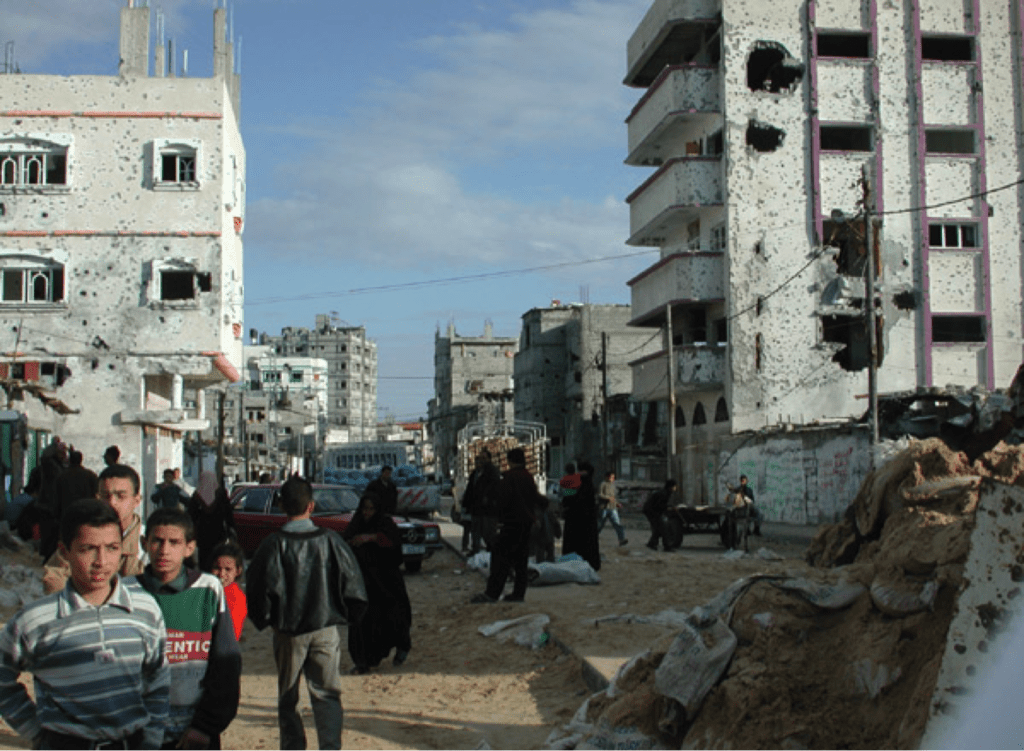
But all of this got left out, making the situation much worse than it ever was.
The whole thing reminds me of this scheme I used to use to get free McNuggets at McDonald’s. It worked like this:
You go to McDonald’s with your friend. You convince him to buy a big 20-pack of McNuggets. Then, as soon as he sits down, you send him back up to the front of the restaurant to get napkins, or ketchup, or whatever. While he’s gone, you flip open the McNuggets box and swipe five or six Nuggets. Then you replace the lid on the box. He comes back, opens the box, and thinks he only got fourteen nuggets, when he paid for twenty. “Go complain to the manager,” you say. Thinking he’s really been ripped off, your friend then goes up to the manager and, with all the gall of a wronged person, angrily demands his six McNuggets. His act is usually so believable that he gets what he wants. It works every time— just make sure you don’t tell him until you’re in the car on the way home.
American coverage of the Middle East works the same way. You cover an Arab-Israeli conflict for years, following a certain storyline. Along the way, you lie to your viewers about what’s really happening, setting them up to think that America’s position in the Middle East is reasonable. Then something like the bombing happens, and you show Palestinians dancing in the streets. Americans then, quite naturally, go completely crazy with rage and demand total retaliation. The lie is in the missing McNuggets. If Americans knew that CNN had stolen them before, they wouldn’t be rushing to the manager for justice now.
Probably no single film clip in recent history has had as much of an impact as the Palestine clip. Summing it up one way was Ehud Sprinzak, an Israeli expert on terrorism, who was quoted in Reuters, referring to the clip:
“From the perspective of Jews, it is the most important public relations act ever committed in our favor.”
Put it another way: in the 48 hours after the clip ran, Israelis shot and killed 13 Palestinians in the Jenin area of the West Bank.
Thirty seconds was all that took. Forget about anyone ever being reasonable when this is the way our leading journalists work.
Matt Taibbi is an author and journalist who has contributed to dozens of publications. He began his career in the former Soviet Union, where he wrote in English and in Russian for more than ten years for papers like The Moscow Times, The eXile, Komsomolskaya Pravda, Trud, Stringer, and Kommersant. After returning to the United States in 2002, he wrote for outlets like The Nation, the New York Press, and Rolling Stone, specializing in campaign trail reporting and coverage of Wall Street. He earned the National Magazine Award for commentary in 2008 and the Izzy Award for outstanding independent journalism in 2020. Taibbi has authored ten books, four of which were New York Times bestsellers. He currently publishes in Racket News on the independent Substack platform and is particularly known for his Twitter files exposés.
Pictures, reports, concern – the media and the catastrophe
By Anja Reschke, Das Erste, Panorama | 09/20/2001 | 9:45 p.m
Translated from the German via Google Translate:
‘…Even more powerful than words: images. The footage of cheering Palestinians flashed across screens around the world a few hours after the attack. They give the impression that half the city is on its feet to celebrate the deaths of thousands of Americans. That’s the cruel message of the pictures, at least at first glance.
Media scientist Professor Martin Töpferholz interprets: “These images of cheering Palestinian children, including some adults, show individuals who are obviously happy. I don’t know whether they are happy about the attacks. I suspect so because we were told so in the reporting I don’t know. The context, the context of its creation is unclear to me.”
If you look closely at the full, unbroadcast footage, you’ll notice that the street around it is quiet. Just a group of excited children in front of the camera. The woman, who will be remembered for her exuberance of joy, shortly afterwards moves on, unmoved. Noticeably a man in a white T-shirt. He encourages the children and he always gets new people involved.
The woman who just left says today that she was promised cake if she was happy in front of the camera. She was horrified when she saw the images on television. She was never happy about the attack on the USA. Truth? Staging?
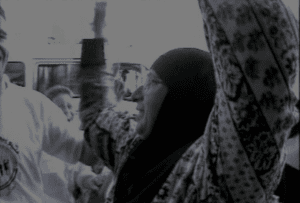
A picture agency transferred the material from the filming location in Jerusalem to the headquarters in London. From here it is distributed to television stations around the world – under the title: Palestinians celebrate in Jerusalem.
The cheering Palestinians also come to Germany via satellite. Images from all over the world appear here, images that evoke strong feelings but are not necessarily a reflection of reality.
“In crises and war situations,” says media scientist Töpferholz, “it is necessary for the viewer and the reader to keep a fair amount of distance from what is being spread by journalists. This has to do with the fact that journalists also make mistakes, that journalists too the information management of politics and the military.”
Anja Reschke is an award-winning German broadcast journalist
The power of TV images: What is the truth?
By Lisa Erdmann, Der Spiegel September 21, 2001, 6:10 p.m
Translated from the German via Google Translate:
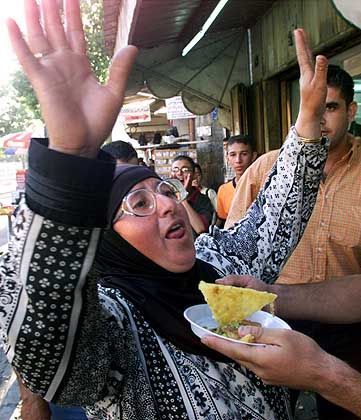
Hamburg – Children cheer, a woman with a black headscarf and glasses raises her arms joyfully, a man claps and waves to other passers-by: a street scene filmed in Jerusalem on September 11th, the day of the attacks in New York and Washington. Images that went around the world. Images that shocked many people. The hunger for information and film material was insatiable that day – so these recordings were broadcast again and again by the TV stations, accompanied by the words that these Palestinians were celebrating the attacks in the USA. But now, ten days after the attacks, the ARD political magazine “Panorama” reports that there may be another truth about these images, that the scene may even have been staged.
The cheering Palestinians were filmed by two news agencies: Reuters and Associated Press (AP). Television viewers only saw a few seconds of the footage last week. In total, the TV stations played around four minutes. Panorama editor Annette Krüger-Spitta took a closer look at the entire tapes from the two agencies. “After all, this is explosive material.” She discovered discrepancies.
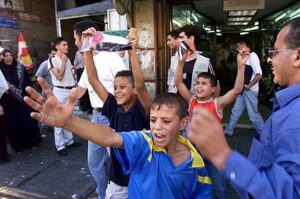
The finished news films last week gave the impression that many people were celebrating in the streets. There were no long shots that showed the entire street, but only small groups of people. However, the footage provided did contain long shots – they clearly showed that only a handful of Palestinians were cheering, while many others simply walked by uninvolved. “The woman with the headscarf later said that she was cheering into the camera because she was promised cake,” said Krüger-Spitta. The Palestinian said she was horrified when she saw the context in which her celebration was shown. She detests the actions in New York and Washington. What is the truth?…
Lisa Erdmann, a top German journalist, has been with Spiegel since 1994.
The Palestinian people, as a whole, portrayed as supportive of the attacks on the World Trade Center and the Pentagon
The Electronic Intifada 12 September 2001

- There are three million Palestinians living in the Gaza Strip and West Bank including Jerusalem, one million Palestinians living inside the borders of Israel, and another four million Palestinian refugees living elsewhere in the world, including the United States. The footage in question depicted between 20 and 40 individuals.
- The Palestinians in the footage were mostly young children. Most of their behaviour in the footage appeared to be no different from how Palestinian children always behave when foreign journalists turn up in their towns, crowding and smiling at the camera and giving the victory sign that has been a symbol of Palestinian steadfastness under Israeli military occupation since the first Intifada in 1987. There is not a single reporter with any experience of carrying a camera into the Palestinian West Bank under any circumstance who couldn’t get similar footage on any day they visited the occupied territories.
- Where genuine rejoicing at the attacks was indeed apparent in the footage, anchors interpreting the footage made no effort to offer any context or background to the images, nor any attempt to separate those Palestinians portrayed from Palestinians as a whole. A comparable situation would be television anchors angrily reacting to scenes of the 1991 riots in Los Angeles, lamenting that “blacks do not respect law and order”, while failing to note the preceding attack on Rodney King or endemic racial profiling of the black community in the U.S. by police forces.
- The overwhelming number of Palestinians, like people of all nationalities, were sickened by the events in New York and Washington. Palestinians with relatives in New York and Washington spent much of yesterday worriedly trying to phone to check they were safe, exactly as many Americans did. Palestinian citizens of the United States will also turn out to be among the victims of the tragedy. Whatever a group of 20-40 Palestinian children happened to be doing yesterday morning in Nablus, East Jerusalem, or Ein Al-Hilweh Refugee Camp in Lebanon is no more representative of all Palestinians than the Klu Klux Klan rally — which happened recently just down the road from where I live, in St. Paul, Minnesota — is representative of all Americans.In addition, there is an all-important context of brutalisation — that anchors completely failed to note — which explains why even a single person would find any cause to celebrate yesterday’s terrible carnage:For the last year now, Palestinian civilians have been living through a nightmare in which Israeli occupation forces have been nightly shelling their towns using tanks, helicopters, and other heavy weapons. Palestinians do not need a subscription to Jane’s Defence Weekly to learn the origin of many of these weapons when they can pick up shell casings from the floors of their homes and from their backyards with MADE IN THE U.S.A. stamped on them. Weaponry used against Palestinians during the Intifada, much of which has been supplied to Israel by the United States or covered at some level by U.S. aid includes:
Heavy weapons:
F-16 fighter planes, Apache and Cobra attack helicopters, and Reshef patrol boats to attack Palestinian buildings and vehicles; and
Armoured pile drivers and armoured bulldozers to destroy Palestinian homes and agricultural land.
Heavy ammunition:
Naval and tank artillery including 76mm, 105mm and 120mm high explosive rounds;
M114 TOW rockets and Hell-Fire air-to-ground missiles;
Shoulder-fired, anti-armour Light Anti-tank Weapons (LAW) rocket launchers firing 84mm or 90mm rockets;
M203 and MK19 grenade launchers;40-90 mm mortars; and
A modified version of the M494 105mm, an anti-personnel cluster bomb.
Smaller ammunition:
5.56 mm bullets for M-16 machine guns;
7.62 mm high velocity bullets for general purpose machine guns and Galil sniper rifles;
12.7 mm bullets for Browning machine guns and Barret sniper rifles; and
The “less lethal” rubber-coated and plastic-coated metal bullets.
See more on LAW: Israeli arms and human rights
The U.S. weaponry listed above has not been used proportionally for the purpose of defending Israel — as one would hope any military aid is used — but rather has been used disproportionally and offensively to kill over 600 Palestinians, one-third of whom are children, 60 percent of whom were killed outside of clash situations. The U.S. weaponry listed above has additionally been used to seriously injure another 15,000 Palestinians, 1,500 of whom have been crippled for life. That Israel has used “excessive force” to suppress the current Palestinian uprising against 34 years of its military occupation is a fact according to the United Nations Security Council, other UN bodies, Amnesty International, Human Rights Watch, Israeli human rights organisation B’Tselem, and the US State Department. However offensive the images of the small groups of Palestinians that were celebrating may be, the fact is that all those depicted in the images — if they are under 34 years of age — have known nothing but military occupation for the entirity of their lives. That celebration was the reaction of only a tiny minority of people in such a situation is a testimony to the Palestinians’ maintainance of human values in a situation devoid of them.
Not only does the United States sell weapons and ammunition to Israel, but many of these weapons are supplied as U.S. aid to Israel. A current figure for U.S. aid currently given to Israel is $3 billion per year, which includes $1.2 billion in economic aid and $1.8 billion in military aid. It is difficult to offer this as a conclusive figure since additional money is given to Israel that is buried in the budgets of individual government agencies such as the Defense Department. Every Palestinian is aware that the U.S. supplies the weapons that Israel uses against them. That celebration was the reaction of only a tiny minority of people in such a situation is a testimony to the Palestinians’ maintainance of human values in a situation devoid of them.
Every Palestinian is also aware that their television screens are never filled with images of Americans protesting the use of their tax dollars to pay for the missiles that shake their cities and create similarly distressing scenes of injured and shocked civilians, as seen yesterday in New York. That celebration was the reaction of only a tiny minority of people in such a situation is a testimony to the Palestinians’ maintainance of human values in a situation devoid of them.
The U.S. media broadcast the footage yesterday without explaining any of the above, something that is neither new nor — any longer — acceptable in light of the anti-Palestinian, anti-Arab and the anti-Muslim sentiment it creates. No organisation of journalists who seek to bring their viewers an accurate representation of reality should be broadcasting contextless, unrepresentative images that encourage racism against nationalities and their associated ethnic groups.In the first few days following the 1995 attack on the Murrah Federal Building in Oklahoma, Arabs and Muslims in the U.S. reported more than 200 incidents of harassment, threats and actual violence. According to reports received by The Electronic Intifada and a press release yesterday from the Council on American-Islamic Relations there have already been reports of harassment and attacks against Arabs and Muslims in the United States. Hate mail and threats have also been directed at The Electronic Intifada and other Palestinian, Arab and Muslim websites.
As those of us who live in the U.S. are currently feeling justifiable anger at the perpetrators behind yesterday’s shocking and horrifying events in New York and Washington DC, let us not misdirect it at an entire people who continue to suffer through one of the darkest periods of their already bleak history. The Palestinian people, who sit glued to their television sets in disturbed silence like the rest of the world, are actually better placed than most to understand what those of us living in America currently feel and are finding it hard to express.
Journallist-web designer Nigel Parry was cofounder of the Electronic Intifada.
RELATED:
- Video: The Israeli Soldiers Moving In To Palestinian Homes Uninvited (2001)
- Documentary: PEOPLE AND THE LAND – Israeli Occupation of Palestine (1997, By Tom Hayes)
- The Information Blockade: The Prism Between Middle Eastern Reality and Americans (1997 – Hayes on censorship of his film)
- As Twitter censorship is revealed, will Palestine remain canceled?
- Hedges, Taibbi, Greenwald discuss censorship (reminiscent of Dorothy Thompson)

